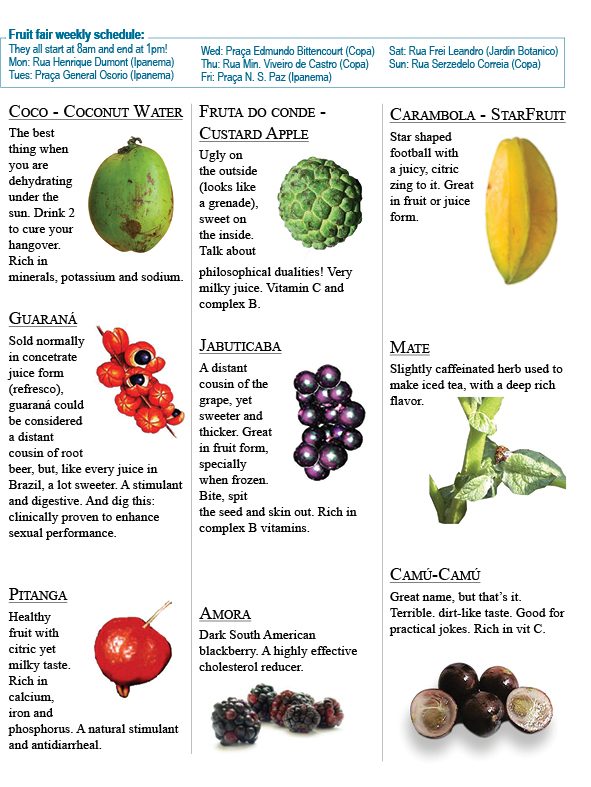Experience the exotic flavors of Brazil through a delightful array of must-try tropical fruits. Discover Brazil’s culinary delights!


Immerse yourself in the vibrant tastes of Rio de Janeiro with an assortment of delectable tropical fruits. Explore Brazil’s culinary wonders and indulge in the flavors of paradise.
Manga – Mango
Considered by many as the ultimate fruit to take with them to a desert island, mango is sweet and creamy, and packed with vitamins A and C. In fact, its tropical flavor makes it a very popular choice.
Maracujá – Passion Fruit
Slightly bitter to the point of puckering your cheeks, yet incredibly refreshing, passion fruit is rich in complex B vitamins and iron. Also, it possesses natural soothing properties that can benefit your overall well-being.
Cajú – Cashew
With its sweet and refreshing taste and distinctive aroma, cashew is a delightful treat. Not only is it abundant in vitamins A, C, and complex B, but it also lowers blood pressure and boosts the immune system.
Goiaba – Guava
Thick, sweet, and smooth, guava is a fruit that stands out. Similar to mango, it is rich in vitamins A, C, complex B, and various minerals. However, it is important to note that guava may not be suitable for individuals with digestive problems.
Cana – Sugar Cane
By extracting the juice on the spot, you can savor its optimal flavor and sweetness.
Abacate – Avocado
This tropical food in Rio de Janeiro is known for its thick and creamy texture, and boasts a wide range of nutrients and vitamins. This makes it an excellent choice for a nutritious breakfast or snack. Also, its versatility allows for various culinary uses.
Mamão – Papaya
Similar to avocados, papaya is highly regarded for its health benefits. Rich in vitamins A and C, it serves as a natural laxative and stress reliever. Consider trying it in the form of a “vitamin,” a refreshing smoothie.
Acerola
Dubbed as the king of vitamin C, acerola surpasses even the citrus lemon in its vitamin C content. In fact, acerola juice offers a pleasant and mildly citric taste, making it a great addition to your diet.
Açaí
Acai shakes, particularly thick smoothies, are best enjoyed with a spoon and can be complemented with granola for added texture. Despite being calorie-dense, acai is rich in proteins, fiber, vitamin E, and minerals, and serves as a natural cholesterol controller.
Coco – Coconut Water
When you find yourself dehydrated under the sun, coconut water is the ultimate thirst quencher. It is recommended to consume two servings of coconut water to cure a hangover. As well as being delicious, it is rich in minerals, potassium, and sodium, replenishing your electrolytes.
Guaraná
Sold in concentrated juice form known as “refresco,” guaraná can be likened to a distant cousin of root beer, with a sweeter taste typical of Brazilian juices. Known to stimulate digestion, guaraná also boasts the intriguing benefit of clinically proven enhancement of sexual performance.
Pitanga
Pitanga is a healthy fruit with a citric yet milky taste. It is a rich source of calcium, iron, and phosphorus, making it a natural stimulant and antidiarrheal agent.
Fruta do conde – Custard Apple
Despite its unattractive appearance resembling a grenade, the custard apple surprises with its sweet and milky juice. This fruit exemplifies the philosophical duality of beauty and taste. Of course, it’s healthy too, containing vitamin C and complex B vitamins.
Jabuticaba
As a distant cousin of grapes, jabuticaba offers a sweeter and thicker fruit experience. It is particularly enjoyable when consumed in its fruit form, especially when frozen. To savor its flavor, simply bite, and spit out the seed and skin. Also, it is rich in complex B vitamins.
Amora
Amora is a dark South American blackberry known for its effectiveness in reducing cholesterol levels. Including it in your diet can contribute to maintaining a healthy cardiovascular system.
Carambola – StarFruit
With its star-shaped appearance and a juicy, citric zing, starfruit is a delightful fruit to enjoy in its natural form or as a refreshing juice. It adds a unique touch to your culinary creations.
Mate
Mate is a slightly caffeinated herb commonly used to prepare iced tea. It offers a deep, rich flavor that is popular among tea enthusiasts. As well as its popularity, it also provides a gentle energy boost.
Camú-Camú
Despite its intriguing name, camú-camú disappoints with its terrible dirt-like taste. However, it compensates with its richness in vitamin C, which makes it a valuable addition to your diet.
Brazil, famed for its dynamic culture and stunning scenery, boasts a rich variety of tropical fruits. This land, from dense rainforests to sunny beaches, provides a bounty of exotic fruits for enthusiasts. Join us in exploring these flavorful tropical delights.
Tropical fruits in Brazil are a culinary adventure waiting to be explored. The diverse selection includes mouthwatering options like mangoes, passion fruits, guavas, and avocados. With their rich flavors, these fruits transport your taste buds to a tropical paradise.
Not only delicious, tropical fruits also offer immense nutritional value. They’re rich in vitamins and minerals, naturally enhancing health and well-being. Plus, they boost immunity, aid digestion, and promote vitality.
Imagine waking up to a refreshing acai bowl, topped with tropical fruits like papaya and pineapple. Or sipping on a revitalizing mango smoothie on a hot summer day. Brazil’s tropical fruits offer endless possibilities for delightful culinary creations.
Whether it’s enjoying a juicy slice of watermelon by the beach or relishing the tangy sweetness of a starfruit, tropical fruits in Brazil are a feast for the senses. Don’t miss the opportunity to indulge in nature’s bounty and experience the flavors that make Brazil a tropical fruit haven.
In conclusion, Brazil’s tropical fruits are a true gift from nature. Their captivating flavors, combined with their numerous health benefits, make them a must-try for fruit enthusiasts. So, embark on a tropical fruit adventure in Brazil and let your taste buds revel in the exotic delights that await!
Go to our FAQ session
